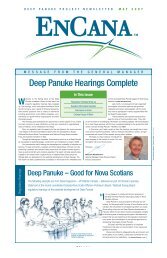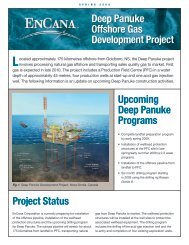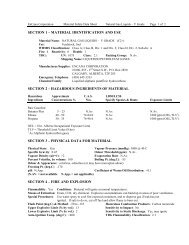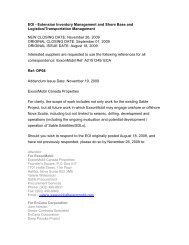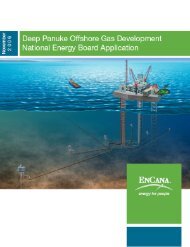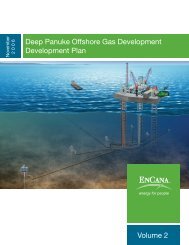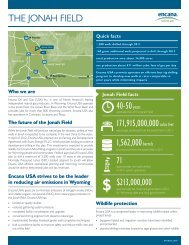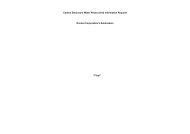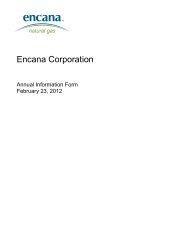Deep Panuke Project Description - Encana
Deep Panuke Project Description - Encana
Deep Panuke Project Description - Encana
Create successful ePaper yourself
Turn your PDF publications into a flip-book with our unique Google optimized e-Paper software.
2.7.1.1 Air PollutantsThe following describes criteria air pollutants (i.e., regulated by federal guidelines or provincial limits)emitted by the <strong>Project</strong>, although some may be emitted in minor amounts and may not necessarily resultin the effects described below unless otherwise indicated in Section 8.1.Nitrogen OxidesNitrogen oxides are produced in most combustion processes, and almost entirely made up of nitric oxide(NO) and nitrogen dioxide (NO 2 ). Together, they are often referred to as NO x . NO 2 is an orange toreddish gas that is corrosive and irritating. Most NO 2 in the atmosphere is formed by the oxidation ofNO, which is emitted directly by combustion processes, particularly those at high temperature andpressure, such as diesel engines. NO 2 is the regulated form of NO x . NO is a colourless gas with no directeffects on health or vegetation at ambient levels. The levels of NO and NO 2 , and the ratio of the twogases, together with the presence of hydrocarbons and sunlight are the most important factors in theformation of ground-level ozone and other oxidants. Further oxidation, and combination with water inthe atmosphere, contributes to the production of “acid rain”.Generally NO 2 constitutes 5 to 10% of the initial total emissions of NO x , and the conversion of themajority of NO occurs after emission to the atmosphere. Emissions information on boilers usually refersonly to total NOx, partly because the conversion rate of NO to NO 2 is somewhat site specific. Forinstance, the amount of NO 2 generated by a stationary combustion turbine can be calculated using theNational Emission Guidelines for Stationary Combustion Turbines set by the Canadian Council ofMinisters of the Environment (CCME). This is accomplished by taking into account the turbine’s poweroutput and heat output, which could potentially be recovered. Other methods for the assessment of NO xeffects include the ozone limiting method.For this <strong>Project</strong>, nitrogen oxides are produced primarily in the generation of power for electrical loadsand compressors. It is estimated that the compression load of 14 to 21 MW and expected electrical loadof 7 MW will be met through the use of combustion turbines.Sulphur DioxideSulphur dioxide (SO 2 ) is a colourless gas with a distinctive pungent sulphur odour. It is produced incombustion processes by the oxidation of sulphur in the fuel. SO 2 can, at high enough concentrations,cause damage to vegetation and adverse health effects impacting the respiratory system.This <strong>Project</strong> incorporates a sulphur management system that removes H 2 S from the gas stream andinjects it into a disposal well. In the event of maintenance requiring downtime, or a malfunction of the<strong>Deep</strong> <strong>Panuke</strong> Volume 4 (Environmental Assessment Report)• November 2006 2-50




